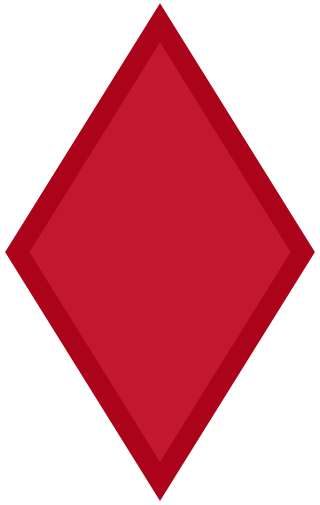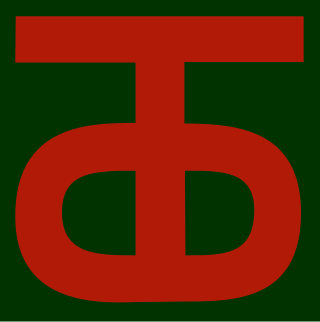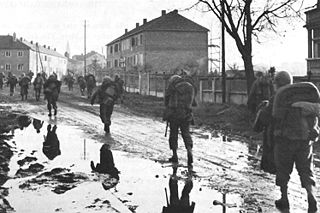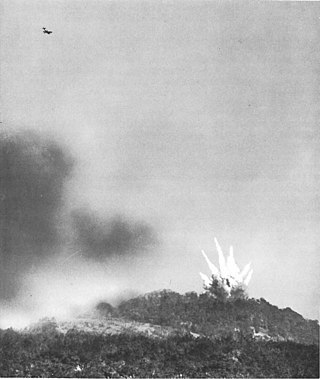
The 7th Armored Division was an armored division of the United States Army that saw distinguished service on the Western Front, from August 1944 until May 1945, during World War II.

The 5th Infantry Division (Mechanized)—nicknamed the "Red Diamond", or the "Red Devils" —was an infantry division of the United States Army that served in World War I, World War II and the Vietnam War, and with NATO and the U.S. Army III Corps. It was inactivated on 24 November 1992 and reflagged as the 2nd Armored Division.

The 90th Infantry Division was a unit of the United States Army that served in World War I and World War II. Its lineage is carried on by the 90th Sustainment Brigade.

The Battle of Nancy in September 1944 was a 10-day battle on the Western Front of World War II in which the Third United States Army defeated German forces defending the approaches to Nancy, France and crossings over the Moselle River to the north and south of the city. The battle resulted in U.S. forces fighting their way across the Moselle and liberating Nancy.

The XII Corps fought from northern France to Austria in World War II. Constituted in the Organized Reserves in 1933, it was activated on 29 August 1942 at Columbia, South Carolina. XII Corps became operational in France as part of Lieutenant General George S. Patton's Third Army on 1 August 1944. Initially commanded by Major General Gilbert R. Cook, bad health forced MG Cook to relinquish command to Major General Manton S. Eddy within three weeks. MG Eddy commanded the corps until late April 1945, when his own health problems forced him to turn over command to MG Stafford LeRoy Irwin.
The 607th Tank Destroyer Battalion was a tank destroyer battalion of the United States Army active during the Second World War. They arrived in England during April, 1944, and entered combat in mid June, landing at Utah Beach. The unit fought across France and into Germany during the summer and early winter of 1944. In late winter, they were then pulled out and sent to Belgium near the end of the Ardennes Campaign and again fought their way into and across Germany, ending the war near the Czechoslovakian border. The 607th received credit for the Normandy, Northern France, Rhineland, Ardennes-Alsace and Central Europe campaigns.

The Battle of Metz was a battle fought during World War II at the French city of Metz, then part of Nazi Germany, from late September 1944 through mid-December as part of the Lorraine Campaign between the U.S. Third Army commanded by Lieutenant General George Patton and the German Army commanded by General Otto von Knobelsdorff. Strong German resistance resulted in heavy casualties for both sides. The city was captured by U.S. forces and hostilities formally ceased on 22 November; the last of the forts defending Metz surrendered on 13 December.

The Battle of Fort Driant was a constituent battle in the 1944 Battle of Metz, during the Lorraine Campaign and the greater Siegfried Line Campaign. The battle was on occupied French territory between the forces of the United States Third Army under the command of General George S. Patton and the forces of Nazi Germany under General Otto von Knobelsdorff and was given the code name Operation thunderbolt.
Fort Jeanne d'Arc, also called Fortified Group Jeanne d'Arc, is a fortification located to the west of Metz in the Moselle department of France. It was built by Germany to the west of the town of Rozérieulles in the early 20th century as part of the third and final group of Metz fortifications. The fortification program was started after the German victory of the Franco-Prussian War, which resulted in the annexation of the provinces of Alsace and Lorraine from France to Germany. The Fort Jeanne d'Arc was part of the Moselstellung, a group of eleven fortresses surrounding Thionville and Metz to guard against the possibility of a French attack aimed at regaining Alsace and Lorraine, with construction taking place between 1899 and 1908. The fortification system incorporated new principles of defensive construction to deal with advances in artillery. Later forts, such as Jeanne d'Arc, embodied innovative design concepts such as dispersal and concealment. These later forts were designed to support offensive operations, as an anchor for a pivoting move by German forces into France.
The 735th Tank Battalion was an independent tank battalion that participated in the European Theater of Operations with the United States Army in World War II. The battalion entered combat in Normandy in July 1944 with the 5th Infantry Division and fought across France with the 95th Infantry Division. When reattached to the 5th Infantry Division, the 735th Tank Battalion played a key role in the reduction of the fortifications of Metz. The battalion was also attached to the 26th Infantry Division during the Battle of the Bulge and fought the last several months of the war attached to the 87th Infantry Division. It was inactivated in October 1945.
The Fort de Saint-Julien, renamed Feste Manteuffel in German, is a military installation near Metz. It is part of the first fortified belt forts of Metz and had its baptism of fire in late 1944 in the Battle of Metz.
The Feste Kameke, renamed Fort Déroulède by the French in 1919, is a military installation near Metz. It is part of the first fortified belt of forts of Metz and had its baptism of fire in late 1944, in the Battle of Metz.

The Feste Wagner, renamed Group Fortifications of Aisne by the French in 1919, is a fort of the second fortified belt of forts from Metz, in Moselle. This group fortification, built in the municipalities of Pournoy-la-Grasse and of Verny, controlled the valley of the Seille. It had its baptism of fire in late 1944, when the Battle of Metz occurred.
The Feste Leipzig, renamed Group Fortifications Francois-de-Guise after 1919 by the French, is a military structure located in the municipality of Châtel-Saint-Germain, close to Metz. It is part of the second fortified belt of forts of Metz and had its baptism of fire in late 1944, when the Battle of Metz occurred.
The Feste Lothringen, renamed Group Fortification Lorraine after 1919, is a military installation near Metz. It is part of the second fortified belt of forts of Metz and had its baptism of fire in late 1944, when the Battle of Metz occurred.
The Feste Mercy, renamed Feste Freiherr von der Goltz in 1911 and then The Group Fortification Marne in 1919, is a military installation near Metz, in the woods between Jury, Mercy and Ars-Laquenexy. It is part of the second fortified belt of forts of Metz and had its baptism of fire in late 1944, when the Battle of Metz occurred.
The Feste Haeseler, renamed Group Fortification Verdun after 1919, is a military installation near Metz. Constituted as forts Sommy and Saint-Blaise, the fortified group is part of the second fortified belt of forts of Metz. It had its baptism of fire in late 1944, when the Battle of Metz occurred.
The Feste Prinz Regent Luitpold, renamed Group Fortification Yser after 1919, is a military installation near Metz. It is part of the second fortified belt of forts of Metz and had its baptism of fire in late 1944, when the Battle of Metz occurred.

The 1139th Engineer Combat Group was a technical United States Army Headquarters Unit providing administration and supervision support to Combat Engineers on bridge building and other construction activities during World War II. The 1139th Engineer Combat Group was part of the Third Army and was attached for operations to the XX Corps in direct support of the 7th Armored Division. The 1139th Engineer Combat Group fought from northern France to Austria in World War II, supporting General George Patton's Third Army's rapid movements during the war.
The 559th Volksgrenadier Division was a volksgrenadier division of the German Army during World War II that fought entirely on the Western Front.











